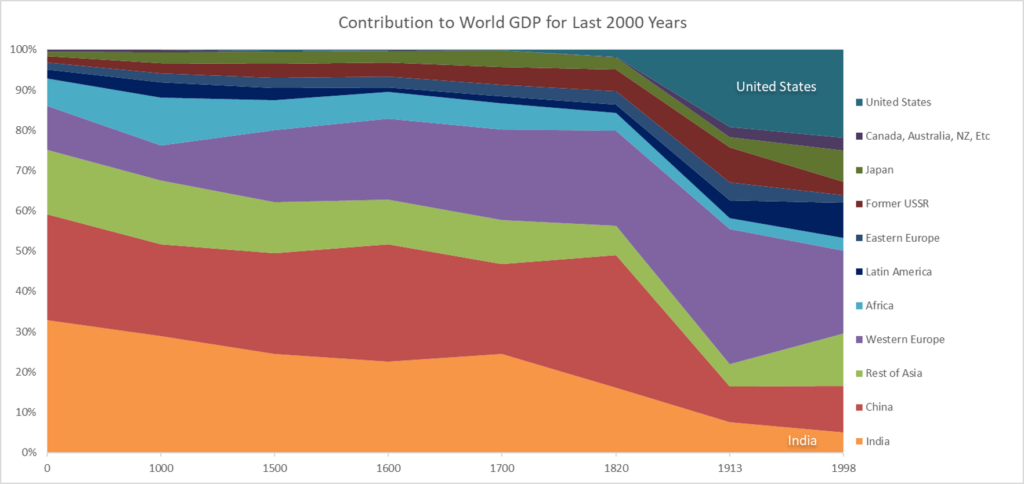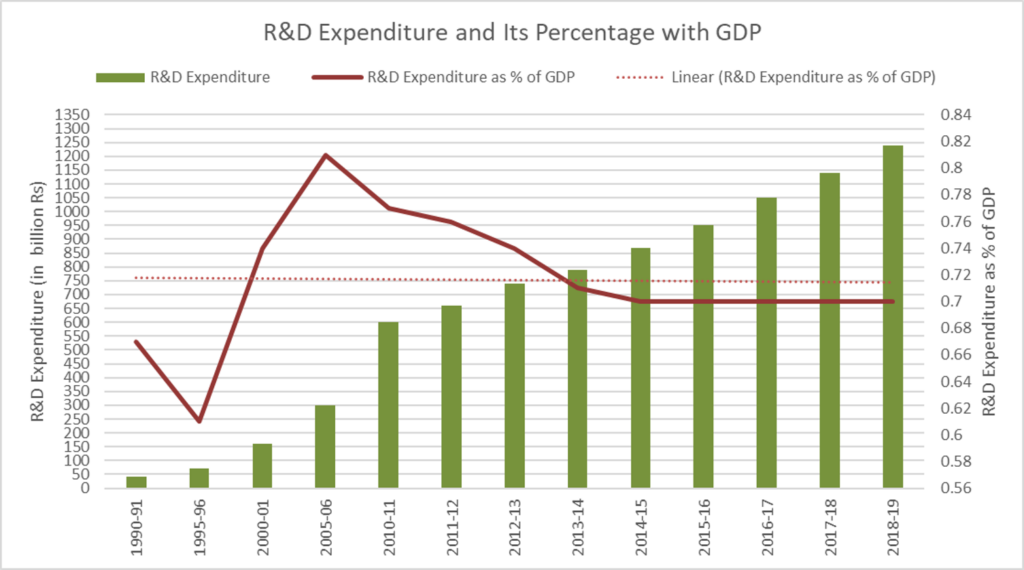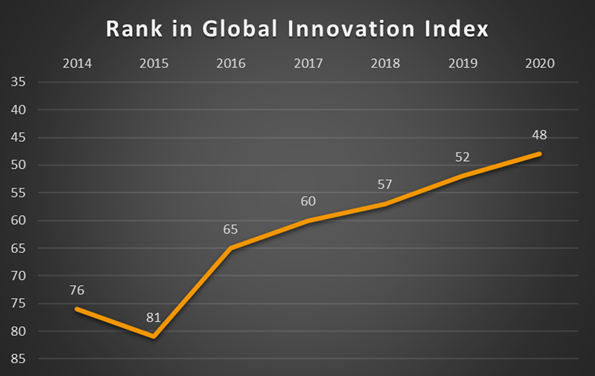When I was in middle school, one morning, one of my classmates came to school with a new fountain pen. He was obviously very happy. Just before the prayer, we were standing in a group. He proudly declared, “See my uncle got me this new pen. It’s a Japanese pen.” We were looking at the pen requesting him to let us see it and use it once, when another classmate said, “I have also got a new pen, see.” To this the first guy said, come on, this is a local Indian pen, mine is a made in Japan”. Without trying any of them, all the kids in the group agreed that the other guy had an inferior quality pen because it was locally manufactured and the Japanese pen was of superior quality. Many a times after that day and even today, when that incident comes to mind, I am amazed about the disdain young kids (and people in general) had towards the products manufactured in India. For a very long time after independence, Indian technology capability and R&D was not looked at with great respect.
Innovation in Ancient India
India is home to the world’s oldest civilization. There is several thousand years of recorded history showing India’s glorious past and how we led the world in business and new discoveries. There are myriad stories about new discoveries and innovations in India in the ancient times. Some of them are:
- The Zero and the Decimal System
- Dentistry
- Plastic and Cataract surgery
- Metallurgical marvels like the Ashoka Pillar
- Flush toilets in Mohenjodaro and Harappa
- …

The graph above shows India’s contribution to world GDP over a period of ~2000 years.
With chaos caused by the changing political situations, India started losing her edge on innovation and new discoveries. The propagation of knowledge from one generation to the next reduced significantly. India’s ancient and indigenous education system was destroyed during the invasions and colonial rule of around 800 to 1000 years. At the dawn of independence, more than 80% of Indian population was illiterate.
While the political turmoil had taken a toll on the development of human capital, after independence, India was again faced with solving some of the very basic problems like food scarcity.
Role of Education System
After independence, India continued the education system and institutions inherited from the British rule. The inherited education systems was focused on creating clerks instead of thinkers and leaders. Well educated folks coming out of the colleges needed extra effort to develop novel ways of thinking. The lack of ability to apply the knowledge gained in schools/colleges made it even worse. Application of acquired knowledge is what makes a skill. If you wander around in the rural areas of India, you would see some very creative ways of solving day to day problems employed by people (for e.g. MittiCool earthenware).
Many of these problem solvers are not formally educated or have fancy college degrees. They solve the problems as way of living their lives. Somehow, this attitude of “solving problem is a way of life”, was wearing away in the people after formal education. They would think more procedurally instead of seeking the problem and hitting it on the head to get the job done. The schools and education system focused on preparing the students for exams instead of preparing them for solving the problems in real life.
Application of Knowledge
Application of acquired knowledge is paramount for any learning and thinking society’s development. Our schools and inherited education system made little effort to explain the students why they were learning the concepts and principles they were learning. There are some higher education institutes like IITs and IISc that focus on the application of knowledge. They conduct both, the closed book and the open book exams. The closed book exam is aimed at learning and knowing the principles and the open book exams are aimed at applying the principles to solve a problem. But its the initial eight or ten years in the school when the foundation of an entire life is being created. The clarity of concepts in the early years is what inspires the child to learn better and seek more. If the foundation is weak, you can’t construct a strong building on it.

Industry Academia Collaboration
Another very important aspect of incubating innovative thinking and making students ready for the challenges is through the collaboration between Academia and Industry. It helps the young students learn the ways of the industry and also work on some real world problems. The industry is benefited such that a vast pool of learners and researchers is available to look at the problems from a completely unbiased and fresh point of view and solve them for the industry. A large number of American universities take extra effort for working closely with the industry. Here is an article explaining the immense benefit for the society when academia and industry collaborate.
When we talk about innovation and R&D at the industrial level, we need to look at the world as a stage. Till 1990s, Indian economy was a closed economy marred by the License and Quota system. Unnecessary government control over the industry killed innovation. Till 1990, there was no/little challenge from other global companies. This prevented the Indian industry from innovating to produce high quality low cost products. This probably explains the mindset I have discussed in the beginning of this article.
Visionless Promotion of R&D
Most of the research bodies in India were inherited from the colonial era. CSIR (Council of Scientific and Industrial Research) was established in 1941, ICMR (Indian Council for Medical Research) was established in 1911, ICAR (Indian Council for Agriculture Research) was established in 1929. Many other bodies that were established after the independence were established ad hoc. They have their own charters and were/are working in silos. Even today there is little collaboration between these research bodies. There is no supervising body presiding over the research activities in the country as a whole.
In the area of innovation, multiple organizations are working as well. These include the innovation cell under the Ministry of Education, the National Innovation Foundation (NIF) and the Atal Innovation Mission (AIM) under NITI Aayog. All these bodies are working in different areas. While AIM is working towards making school children more innovative with Atal Tinkering Labs (ATL) setup in chosen schools, Ministry of Education is running Smart India Hackathons for the undergraduate Engineering students. The NIF is working in the field to identify and disseminate grass root innovations being practiced by common people. The NIF works to preserve the traditional knowledge being passed on to Indians from generations. While all these bodies are working in different areas, having them under one roof will help create a seamless approach towards developing innovative thinking for students and entrepreneurs.
Expenditure on R&D
India has been consistently increasing her expenditure on R&D over the decades. Yet, it has not increased at the same pace as the growth of Indian economy.

For last 20 odd years, India has spent close to 0.7% of her GDP towards research. Compared to other developed countries, this is meager.
I analyzed the Top 14 countries on the Global Innovation Index (2020) and their corresponding spending on R&D. These countries spend a huge amount of money on R&D. Below is a treemap chart showing the rank of the country in GII and the amount of money spent on R&D as percentage of their respective GDP. Almost all these countries (except China) fall in the high income group. Their expenditure on research is huge. These countries also have well established mechanism for directing research in the areas strategically identified according to their needs. In absolute terms, US is the biggest spender on R&D. Yet, US is on number three behind Switzerland and Sweden in the GII ranking.

Way Further
India’s R&D ecosystem has five major players. These are:
- Central Government
- State Governments
- Public Sector Companies (under central government)
- Private Sector R&D Companies
- Higher Education Institutes
Out of these, the Central government is the biggest spender on R&D. In most of the countries listed above, majority of R&D expenditure is done by the business corporations.
- India needs to incentivize the R&D in private sector.
- Now that Indian industry is taking the centerstage with many world class products being manufactured in India, academia should not miss the opportunity. Promoting collaboration between the Industry and Academia may actually help hit two birds with one stone.
In industry-academia partnership, generally the discussion gets stuck on the ownership of intellectual property (IP). Devising a transparent and rule based framework to determine and decide the ownership of IP in the partnership will take the industry-academia collaboration in India to new heights. The aim should be to help the partnering bodies arrive at an agreement.
India is showing great talent and commitment with third largest technology startup ecosystem in the world. India has also produced quite a few Unicorns (Startups with more that a billion dollar valuation). But, at present, most of startup promotion and support is being done by the central government. State governments need to actively get involved in promoting entrepreneurship and innovation in their respective states.
India should attract more companies to setup their R&D operations. This is already going on with the GOI going full throttle on reforms to improve the ease of doing business (EODB) in the country.
The New Education Policy (2020)
The New Education Policy 2020 (NEP) published by the GOI aims at preparing students for the new challenges being posed by the changing world. The NEP focuses on interdisciplinary studies in higher education to develop the spark of innovation in students. Cross disciplinary thinking helps spur innovation through imaginative reuse. I have talked about imaginative reuse as one of the very powerful model of innovation in one of my earlier articles. The NEP also aims at having a single regulatory body in place of multiple bodies like AICTE and UGC today. One of the very important feature of the NEP is that it aims at creating a mechanism for carefully tracking the students and their learning levels to make sure that they are enrolled and acquiring knowledge. The NEP also aims at providing suitable opportunities to ‘reenter and catchup’ to the students that have fallen behind.
While the NEP promises to change the education horizon of India, a lot will depend on how effectively the policy is implemented.
Strategy Driven Growth for the R&D Initiatives
India needs a parent body that can oversee all the R&D related activities in country. A supervising authority that can coordinate the Research effort across the board. The current spending on R&D across various governments and private organizations is tough to track as it is reported in aggregate form under other headings. That makes it cumbersome to understand the actual amount of money being spent on R&D. There needs to be a more transparent and clear way of identifying expenditure on the research work. With that, the allocation of resources to respective bodies will be easier and more effective.
The parent body should also oversee the collaboration between various research bodies to ensure the R&D activities move ahead with a vision. The idea is to ensure no research organization is working in silo. Looking at the emergence of Artificial Intelligence (AI) and its application by the industry, we can take it as an example. At a basic level, the AI is an opportunity for achieving better productivity by automating the non core activities. Well planned development and application of AI in research activities can help the researchers devote more time to the core investigative work in their areas of research. If each research body puts separate effort for application of AI, the results may be sub optimal. But, having a supervising parent body will help do it with a bigger picture in mind. Reuse the best practices across the board and learning from the failures of others can help make the overall research community in India, more productive and effective.
The supervising body needs to be more like an administrative body with a keen scientific temper. Having a plane scientific body or a plane administrative body won’t work. Also, the parent body will need to have a clearly defined charter to ensure management and administration of research activities is carried out efficiently. The Economic Advisory Council (EAC) to Prime Minister has recommended that India should spend 2% of her GDP on R&D by 2022. Looking at the numbers it will be close to 4 trillion rupees. To spend such a huge amount of money effectively with good ROI, a complex research plan keeping in mind the short and long term strategic needs of India will need to be drawn and executed. It is just not possible without a common parent authority supervising it.
While there is a lot to do, a lot has also been done in last few years. Various initiatives like AIM, StartupIndia and others brought in by the government are helping India move ahead on the path of Innovation and Research.

For the first time now, India has figured in Top 50 most innovative countries in the world. Country’s improving rank in the Global Innovation Index for last five years is a testimony of the effort India is putting to regain her lost glory as a beacon of novel thinking.
- Four Growth Strategies to Scaleup Your Business - March 14, 2021
- Innovative India: Platforms For Billion+ People - January 5, 2021
- Innovative India: Searching For Lost Glory - October 15, 2020



Beautifully & well expressed….. Comparison of ancient to modern education is great…
It is definitely inspire to think what actually education should aim at…..